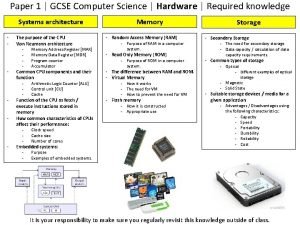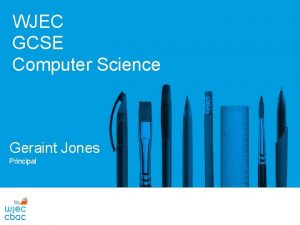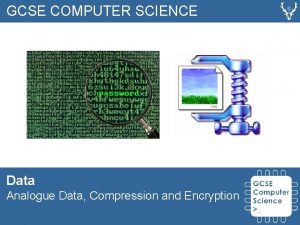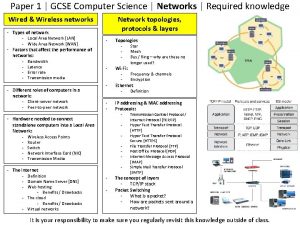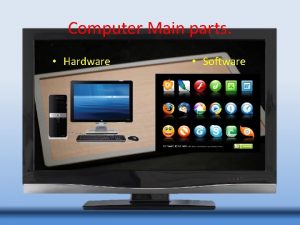Paper 1 GCSE Computer Science Hardware Required knowledge





- Slides: 5

Paper 1 | GCSE Computer Science | Hardware | Required knowledge Systems architecture - - The purpose of the CPU Von Neumann architecture Memory Address Register [MAR] Memory Data Register [MDR] Program counter Accumulator Common CPU components and their function Arithmetic Logic Counter [ALU] Control unit [CU] Cache Function of the CPU as fetch / execute instructions stored in memory How common characteristics of CPUs affect their performance: Clock speed Cache size Number of cores Embedded systems: Purpose Examples of embedded systems. Memory - Random Access Memory [RAM] - - - Purpose of RAM in a computer system. Read Only Memory [ROM] - Purpose of ROM in a computer system. The difference between RAM and ROM. Virtual Memory - How it works - The need for VM - How to prevent the need for VM Flash memory - How it is constructed - Appropriate use Storage - Secondary Storage - The need for secondary storage - Data capacity / calculation of data capacity requirements. - Common types of storage - Optical - Different examples of optical storage - Magnetic - Solid State - Suitable storage devices / media for a given application - Advantages / Disadvantages using the following characteristics: - Capacity - Speed - Portability - Durability - Reliability - Cost It is your responsibility to make sure you regularly revisit this knowledge outside of class.

Paper 1 | GCSE Computer Science | Networks | Required knowledge Wired & Wireless networks Network topologies, protocols & layers - Types of network - Local Area Network [LAN] - Wide Area Network [WAN] - Factors that affect the performance of networks: - Bandwidth - Latency - Error rate - Transmission media - Different roles of computers in a network: - Client-server network - Peer-to-peer network - Topologies Star Mesh Bus / Ring – why are these no - Wi-Fi: Frequency & channels Encryption Ethernet Definition - - Hardware needed to connect standalone computers into a Local Area Network: - IP addressing & MAC addressing Protocols: - Wireless Access Points Router Switch Network Interface Card (NIC) Transmission Media - - The Internet - Definition - Domain Name Server [DNS] - Web hosting - Benefits / Drawbacks - The cloud - Benefits / Drawbacks - Virtual networks longer used? - Transmission Control Protocol / Internet Protocol [TCP/IP] Hyper Text Transfer Protocol [HTTP] Hyper Text Transfer Protocol Secure [HTTPS] File Transfer Protocol [FTP] Post Office Protocol [POP] Internet Message Access Protocol [IMAP] Simple Mail Transfer Protocol [SMTP] The concept of layers - TCP/IP stack Packet Switching - What is a packet? - How are packets sent around a network? It is your responsibility to make sure you regularly revisit this knowledge outside of class.

Paper 1 | GCSE Computer Science | System software | Required knowledge - Purpose of systems software Functionality of systems software. - Operating systems [O. S. ]: - Example of current O. S. - User interface - Command line - Graphical User Interface [GUI] - Voice input - Memory management / multitasking - Peripheral management & drivers - User management - File management - Utility system software - Why is utility software needed? Examples: - Encryption software - Defragmentation - Data compression - Lossy - Lossless - The role and methods of backup: - Full - Incremental - It is your responsibility to make sure you regularly revisit this knowledge outside of class.

Paper 1 | GCSE Computer Science | System security | Required knowledge - Forms of attack - Passive vs. Active - Threats posed to networks (how each is carried out // suitable examples): - Malware - Phishing - Social engineering (people as the weak point in secure systems) - Brute force attacks - Denial of service attacks - Data interception and theft - The concept of SQL injection - Poor network policy. - Identifying and preventing vulnerabilities: - Penetration testing - Network forensics - Network policies - Anti-malware software - Firewalls - User access levels - Passwords - Encryption - Symmetric - A-Symmetric It is your responsibility to make sure you regularly revisit this knowledge outside of class.

Paper 1 | GCSE Computer Science | Ethical, legal, cultural & environmental issues | Required knowledge These are issues that deal with issues such as peer pressure, who makes the technology, child labour etc. - How to investigate & discuss Computer Science technologies while considering: - Ethical issues - Damage to environment making and disposing of technology. Also energy required and placement of satellites. - Definition - Examples Legal issues - Definition - Examples Cultural issues - Definition - Examples Environmental issues - Definition - Examples Privacy issues - Definition - Examples - How key stakeholders are affected by technologies. - Environmental impact of Computer Science. - Cultural impact of Computer Science. - Open source vs. Proprietary software. - Legislation relevant to Computer Science - The Data Protection Act 1998 - Computer Misuse Act 1990 - Copyright Designs & Patents Act 1998 - Creative Commons Licensing - Different levels of licensing. - Freedom of Information Act 2000 How has our culture changed? Home working, emails not post, eg Christmas cards. Who owns the data? Security and DPA It is your responsibility to make sure you regularly revisit this knowledge outside of class.
